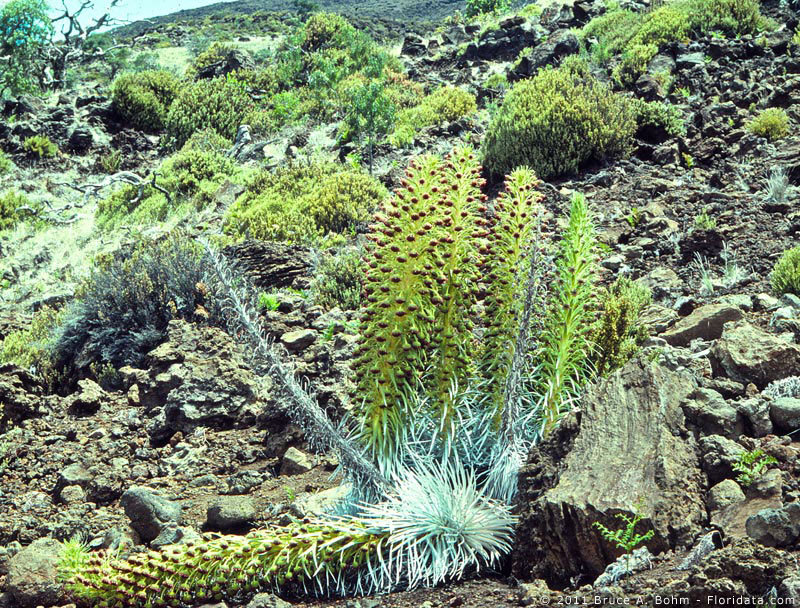
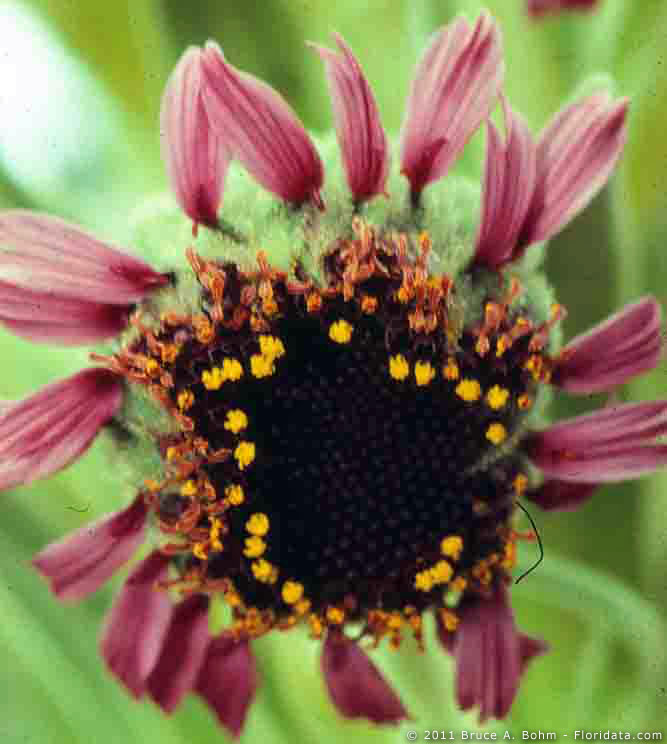


The Asteraceae, or Compositae in the alternative nomenclature, is one of the biggest, most widespread, and certainly one of the most easily recognized flowering plant families on the planet. [I once heard a seminar speaker suggest that the most likely first plant to be discovered on some other planet will be the dandelion.] The family, with 1590 genera and an estimated 23,600 species (Mabberley, p. 207), is cosmopolitan in distribution (none in Antarctic islands). The Hawaiian Islands have their fair share of representatives considering the size of the archipelago. The high concentration of comps (the familiar term for members of the family) on the islands is the result of two overriding factors, the ease of movement of propagules (primarily seeds), and the ready availability of welcoming habitats, open and available niches in the case of the early colonizers, and ample disturbed landscape for the later weedy opportunists. The Hawaiian flora boasts 182 species in 76 genera according to the Manual, although, as I'll point out below, the number of species has grown since publication of that authority. Species endemism, although not the highest percentage in families on the islands, is still about 50%. Of the 76 genera on the islands, six are endemic; they are, with number of species in parentheses: Argyroxiphium (5), Dubautia (26), Hesperomannia (3), Lipochaeta (20), Remya (3), and Wilkesia (2). Although Lagenifera (3) and Tetramolopium (11) are not endemic genera, they have endemic species on the islands (numbers shown). Several genera, otherwise of much broader distribution, are represented on the islands by endemic species, as well as naturalized ones: Artemisia (4, 3 endemic), Bidens (23, 20 endemic), and Gnaphalium (syn. Pseudognaphalium) (3, 1 endemic).
I doubt that I would get much argument in my nomination of a member of Asteraceae as the most photogenic of native Hawaiian plant species: Argyroxiphium sandwicense subsp. sandwicense (see above images) in all its floral glory. Many people, including some native Hawaiians, to whom I have spoken about the silversword, are aware only of the so-called Haleakalä silversword and have never heard of the plant that grows on Mauna Kea on the Big Island. This is not surprising since the once widespread Mauna Kea silversword is now restricted to a fenced area at 9,500 ft elevation on the eastern flank of the mountain, an area that requires following a very rough track followed by an uphill hike to see the plants. The plants grow inside an enclosure designed to keep them safe from feral pigs and sheep. A population of Mauna Kea silverswords is maintained in a fenced garden adjacent to the parking lot at the visitors' center at the Onizuka Center for International Astronomy, also known as Hale Pöhaku (Stone House). The author and a clump of young silverswords are shown in the illustration that accompanies the Introduction. This facility, located at about 9,300 ft elevation, is the mustering point for private vehicles heading for the summit.

The sister subspecies, A. sandwicense subsp. macrocephalum (literally, large-headed silversword), which grows on the upper flanks and in the crater of Haleakalä on Maui, is a lot easier to see (image left). For the benefit of visitors who do not wish to hike to the silversword site in the crater, the National Park Service maintains several specimens in a small garden in front of the visitors' center, and in another garden at the upper parking lot. The Shifting Sands Trail leads from the main parking lot into the crater providing hikers with the experience of seeing the silversword firsthand. There are other attractions along this trail including shelter (Holua cabin) where visitors can arrange to stay overnight before returning to the parking lot on the Shifting Sands Trail, or continuing out of the crater via the Halemau`u Trail. For visitors wishing to see the silverswords in their natural habitat, but who do not wish to undertake the hike, there are guided horse trips available.
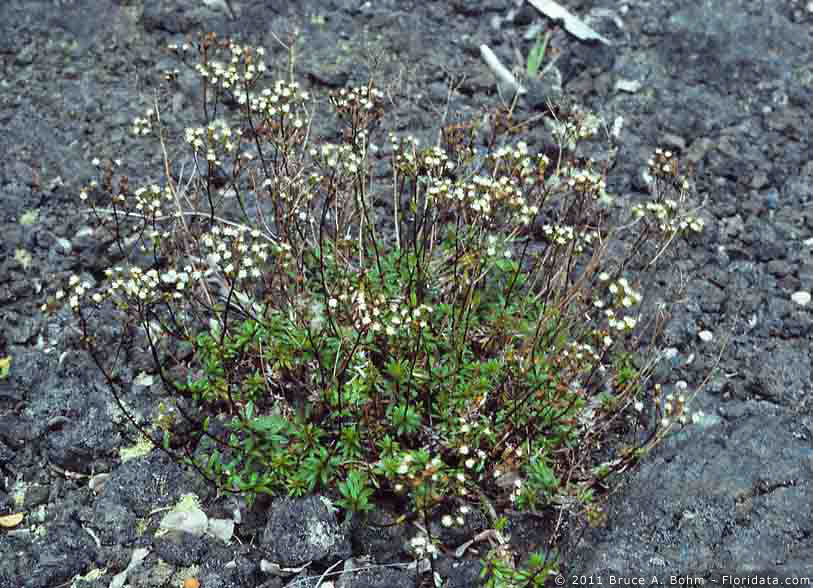
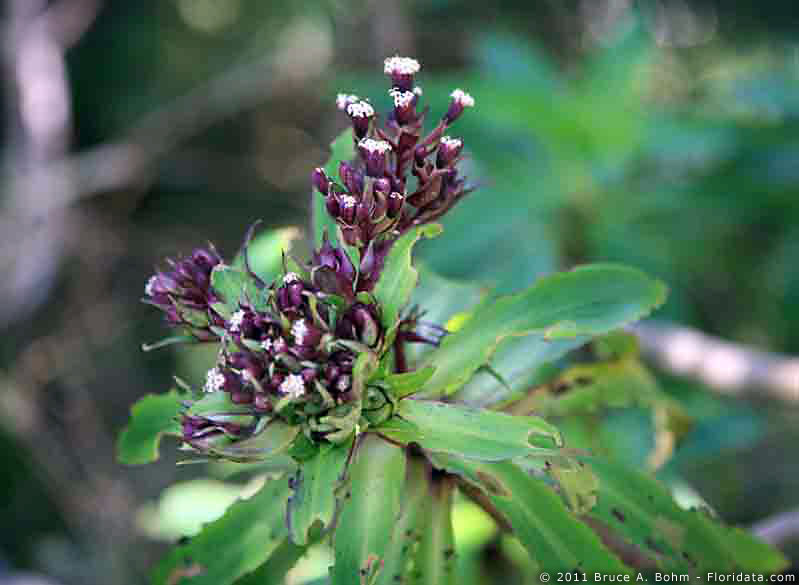


Isabella Bird, an 18th century Englishwoman, world traveler, naturalist, and prolific writer, spent six months on the islands during 1873. Ms. Bird was an astute observer well versed in botany–the mark of any well brought up Englishwoman of the time–and equally skilled at describing her observations in detailed letters to friends in England. In a letter dated May 12 she described her visit to Maui including a visit, on horseback, to see the sunrise from the summit of Haleakalä. As the summit area began to fill with clouds near midday, the group began their descent and "…not far from the ragged edge of the crater…we came upon what we were searching for; not, however, one or two, but thousands of silverswords, their cold, frosted silver gleam making the hill-side look like winter or moonlight. They exactly resemble the finest work in frosted silver, the curve of their globular mass of leaves is perfect, and one thinks of them rather as the base of an épergne for the imperial table, or as a prize at Ascot or Goodwood, than as anything organic. A particular altitude and temperature appear essential to them, and they are not found straggling above or below a given line." The party apparently did not descend into the crater itself where this subspecies also occurs. At a later point in her narrative she described her visit to the summit of Mauna Kea, again by horseback, but did not mention having seen silverswords on either the ascent or descent. We will encounter Ms Bird's observations again.
Closely related to Argyroxiphium are two other genera, Dubautia with 26 species and Wilkesia with just two. Together, the three genera constitute the silversword assemblage owing to several morphological features held in common, and as we will presently see, their evolutionary history. Species of Dubautia occur on all of the main islands and are readily found in their native habitats. Dubautia scabra (see image), for example, is one of the first plants to colonize new lava, such as the cinder field along the Devastation Trail in Hawai`i Volcanoes National Park. In the contrasting rainforest environment of Kaua`i, visitors can see one of the larger members of the genus, D. raillardioides (see image), which occurs abundantly along the boardwalk portion of the Pihea Trail. A larger species, D. arborea (see image), occurs at high elevation (6,000'-10,000', ca. 1,830 m - 3,050 m) on Mauna Kea. In the absence of flowers D. plantaginea (see image), which occurs in wet habitats on all of the main islands, except Ni`ihau and Kaho`olawe, can be confusing to the uninitiated owing to its long, lily-like leaves
The third genus in this trio is Wilkesia. Both of its species occur only on western Kaua`i. The more common of the two, W. gymnoxiphium (see images below), iliau in Hawaiian, is easily seen in its natural habitat, here on the rim of Waimea Canyon. This viewpoint is part of the Iliau Loop area, which features a large population of W. gymnoxiphium. This area also serves as the trailhead for the Kikuyu Trail into the canyon. In contrast to the ready access to iliauthat this sites provides, the rare and endangered W. hobdyi, the dwarf iliau, occurs on the farthest points of western ridges of the island and is not easily visited at all, unless you are a goat, in which case you might not find any plants left anyway since your relatives have likely eaten them. The two species can be seen growing together in the Limahuli Garden on Kaua`i (see image). Both are mature plants that have not yet flowered.
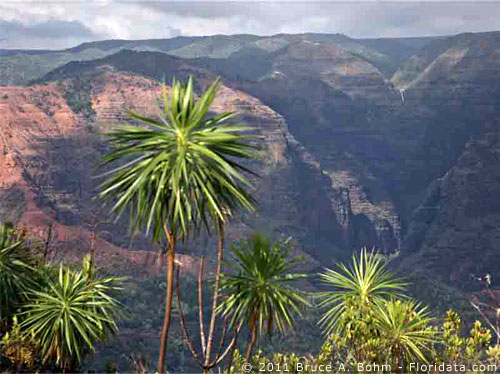
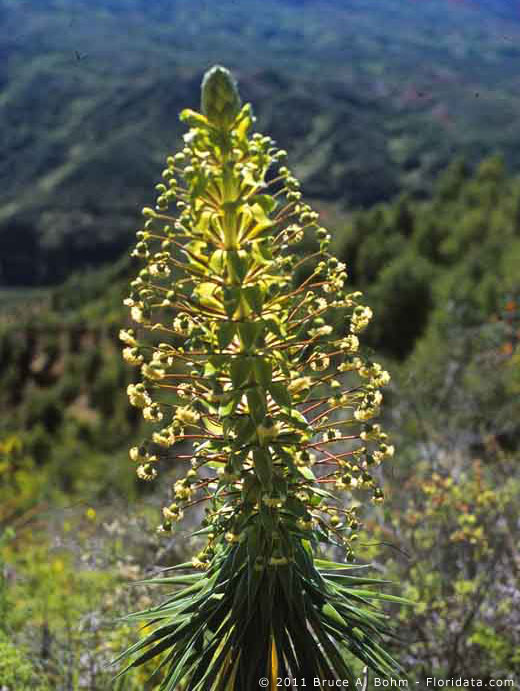
In addition to being among the most photogenic plants in the islands, the silverswords have played a key role in understanding the history of the Hawaiian flora specifically, and in the study of oceanic islands in general. A bit of history will set the scene. Apparently the first European to set eyes upon the silversword was the Scottish botanist John Macrae in 1825. Macrae was a botanist aboard H. M. S. Blonde. This ship, incidentally, commanded by Captain the Right Honorable Lord (George Anson) Byron, cousin to the poet, was the vessel chosen to return the bodies of King Kamehameha II (Liholiho) and his queen, Kamamalu, to the islands. These members of the Hawaiian royal family had contracted measles during their visit to England and died there.
One of the adventures described by Macrae was his party's assent of Mauna Kea, thought to have been the first assent of that mountain by Europeans. Among the many things that the party experienced on that ascent was a sighting of the plant that would ultimately come to be known as Argyroxiphium sandwicense, ahinahina in Hawaiian. From Macrae's journal, we learn that the silversword is, "…truly superb, and almost worth the journey of coming here to see it on purpose." Although my own first sighting of silverswords did not involve a many-day trek from the coast on horseback, with the loss of colleagues along the way, it was memorable enough. On all of my visits to the islands over a period of more than 45 years I have seen new things; none stick in my memory like the first sighting of a silversword.
Macrae's specimens would eventually find their way back to Europe where the Swiss botanist Augustine-Pyramus de Candolle gave it the name by which we know it by combining the Greek words for silver (argyro) and sword or dagger (xiphium) to give the generic name Argyroxiphium). The specific epithet, sandwicense, recognizes the plant's origin as the Sandwich Islands, the name given to the archipelago by Captain James Cook to honor his patron the Earl of Sandwich. A later expedition to the Hawaiian Islands, the United States Exploring Expedition of 1838-1842, resulted in the collection of many specimens including a silversword-like plant from Haleakalä, the grand volcanic mountain that is East Maui. These specimens were given to Asa Gray, the preeminent botanist at Harvard University, who recognized the specimens as being closely related to the Mauna Kea silversword, but because of its somewhat larger flowering heads, opted to recognize it as a species in its own right: Argyroxiphium macrocephalum (Gray, 1852). Eventually, it was recognized that the similarities between the Mauna Kea and Haleakalä silverswords are greater than their differences and that the two should be recognized as subspecies, A. sandwicense subsp. sandwicense, and A. sandwicense subsp. macrocephalum, a distinction that is recognized today.
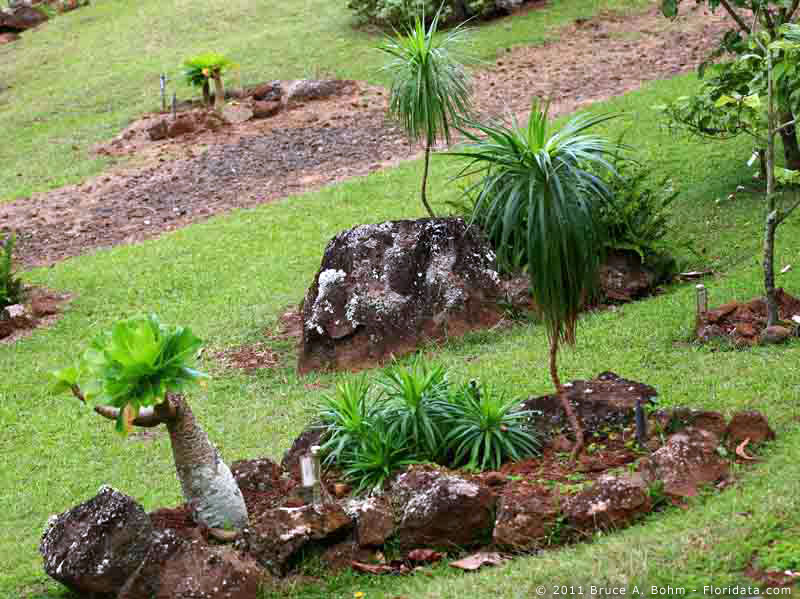
As noted above, the Hawaiian name for this species (both subspecies, actually) is `ahinahina, a name that is based upon `ahina a word meaning gray, or gray- or white-haired (I'd qualify for this one). `Ahinahina is a reduplicated form of `ahina, a common aspect of the language. In using this term to identify the silversword, Hawaiians are referring to its color. The use of silver in its name is a European invention; Hawaiians had no concept of, and hence no word for, silver. A problem arises when one realizes that several other plants that have white or grayish surfaces are also called by the same name most of which we will encounter in this book. They include species of Artemisia, Geranium, Heliotropium, Tillandsia, and a variety of sugar cane with a gray-green, rosy flush (Pukui & Elbert, p. 71). As in many instances with the Hawaiian language, context dictates meaning. I have never had any problem communicating with native Hawaiian speakers (in English) about the various plants just listed. It is simply necessary to describe where the specimens were found and provide a few additional details.
We return now to a critical issue arising from Asa Gray's study of the silversword specimens. Gray and his colleagues were familiar with the flora of California which includes a group of species referred to as the tarweeds (technically, the Madiinae), so named because of the sticky, tar-like exudate on their leaves and stems. On the basis of structural similarities between flowers of the silverswords and the tarweeds, Gray speculated that the two groups were related. This idea rested quietly in the botanical literature until the 1930s when David Keck, a California botanist at the Carnegie Institute at Stanford University, with extensive experience with the tarweeds, challenged the relationship (Keck, 1936). The challenge was based upon several ideas that quite naturally reflected conservative evolutionary and geological thinking of that time.
The first problem with the suggestion of a close relationship between island and continental species involved the distance separating the two sites. Since it was at that time inconceivable that plants, or their propagules, could travel over such immense distances, it was suggested that there must be some other explanation for seemingly closely related organisms being separated by several thousand miles of ocean. Before the idea of long distance dispersal gained wide acceptance in the botanical community, it was usually argued that land bridges of some sort must have existed over which plants moved. Relationships between Hawaiian and North American organisms might, therefore, be explainable by postulating a land bridge between the two; similarly, a land bridge might be needed to explain apparent affinities of Hawaiian and southeast Asian organisms. Another view of the Hawaiian Islands held that the archipelago consists of the remnants of a once much larger land mass–possibly of continental dimensions–that has since subsided leaving only the tips of mountain ranges above water. It takes quite a long time for a land mass, especially a large one, to subside, so it is necessary to bring the element of time into our discussion here.
Two features of the Hawaiian flora suggested that it was ancient, the high level of endemism, and the many species that consisted of one or only a few populations–or even just a few individuals in some cases. The general thinking was that levels of endemism seen in oceanic floras could only have developed over long periods of time, and in the case of the Hawaiian flora with the highest level of species endemism of any archipelago (of equal area) estimated at nearly 90%, a very long time indeed must have been required. The high percentage of species represented by very small populations strongly suggested to workers at the time that these taxa were approaching the end of the line, again, an indication of an ancient flora. It is useful to remind readers that at that time–the early years of the 20th century–information on island age was not available, the concept of (very) long distance dispersal of propagules was a radical view, and a more definitive understanding of evolutionary relationships provided by molecular genetic analysis–taken for granted today–was simply not available. So, it is not all that difficult to see why Keck and his contemporaries went to such lengths to explain that the origin of the silverswords involved somewhere other than North America.
This situation was about to change, however, leading to one of the most intensive series of investigations of any oceanic islands system ever undertaken, research ultimately making the silversword-tarweed story the benchmark against which other systems would be compared. The revolution started with the work of Sherwin Carlquist, a plant anatomist at the Rancho Santa Ana Botanical Garden in Claremont, California. A keen observer of Hawaiian natural history, Carlquist summarized his observations in two important books, one devoted entirely to the Hawaiian Islands, and one of a more general nature (Carlquist, 1974, 1980). Comparative studies of representatives of the silversword alliance and mainland tarweeds convinced Carlquist that Gray's original view was correct: the two groups together constitute a well defined–robust in the usual jargon–subtribe Madiinae (Carlquist, 1959). Experimental studies were soon to follow among which were controlled crosses between species of the two groups undertaken by Gerald Carr of the University of Hawai`i at Mänoa and Donald Kyhos of the University of California at Davis (Carr and Kyhos, 1981, 1986; see also Carr et al. 1996). Successful crosses were observed in some combinations with some of the hybrid offspring capable of producing viable pollen, a feature generally taken to indicate a close genetic relationship between the crossed species. DNA sequence studies by Bruce Baldwin at the University of California at Berkeley and his students strongly supported the uniformity of the subtribe and that the islands were indeed colonized by a continental ancestor (Baldwin and Wessa, 2000). Valuable information on the history of the silverswords came from the DNA data; thus the age of the silversword alliance on the islands was estimated to be of the order of 5.2 million +/- 0.8 million years (Baldwin and Sanderson, 1998), well within the time during which high islands existed, e.g., Kaua`i is estimated to be a little over five million years old. Nihoa, the remnant island that lies northwest of Kaua`i, would have existed as a high island at that time, and could have provided habitats suitable for colonization.
This very brief discussion does not do justice to either the complexity of the phenomenon, or the efforts on the part of the several research groups to unravel its mysteries. The interested reader can get a detailed picture of the Hawaiian members of the Madiinae in Carr's monograph (1985). A more recent, and comprehensive review of all aspects of the research on the subject can be found in Tarweeds and Silverswords. Evolution in the Madiinae (Asteraceae) edited by Carlquist, Baldwin, and Carr (2003).
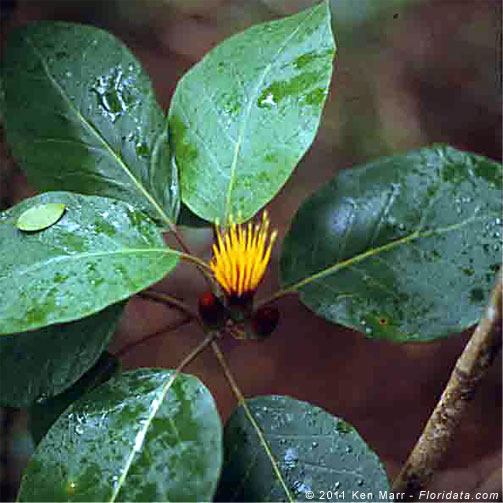
In contrast to the comparative abundance of the three endemic genera in the silversword alliance, we will next meet two small endemic genera that are very rare and very much endangered, Hesperomannia and Remya. Hesperomannia consists of three species, H. arborescens, known from three sites, one on O`ahu, one on Moloka`i, and formerly, one on Läna`i; H. arbuscula, known from O`ahu and a site on West Maui; and H. lydgatei, known only from a single site on Kaua`i. During field collections of Lysimachia (Primulaceae, see below) specimens for his dissertation, Ken Marr, now at the Royal British Columbia Museum, photographed H. arbuscula (image) in the Wai`anae Mountains, the western range on O`ahu.

Remya also consists of three species, R. kauaiensis, a Kaua`i endemic; R. mauiensis, known only from a few sites on Maui; and R. montgomeryi, known from a single location on the steep cliffs of Kalalau Valley, Kaua`i. The major risk to R. montgomeryi is the grazing behavior of feral goats that inhabit the valley. The very rare R. kauaiensis was originally known from only four populations, with no more than a half dozen individuals in each in the Koke`e area of Kaua`i. In the early 1980s this species was considered to have gone extinct until two populations were found in 1983 and two more in 1985. The photograph of this species was taken by Ken Marr in 1990.
The next member of Asteraceae that we will meet is the genus Bidens, beggars ticks to anyone who has ever picked up the little two-pronged fruits while hiking. The pair of teeth on the fruits (literally, bi-dens) is the origin of the generic name of this collection of widespread weedy species. There are about 200 species in the genus (Mabberley, p. 104), 19 of which occur on the Hawaiian Islands. The Hawaiians referred to most varieties of Bidens as ko`oko`olau. A tea made from dried leaves of ko`oko`olau was, and still is, a popular drink.
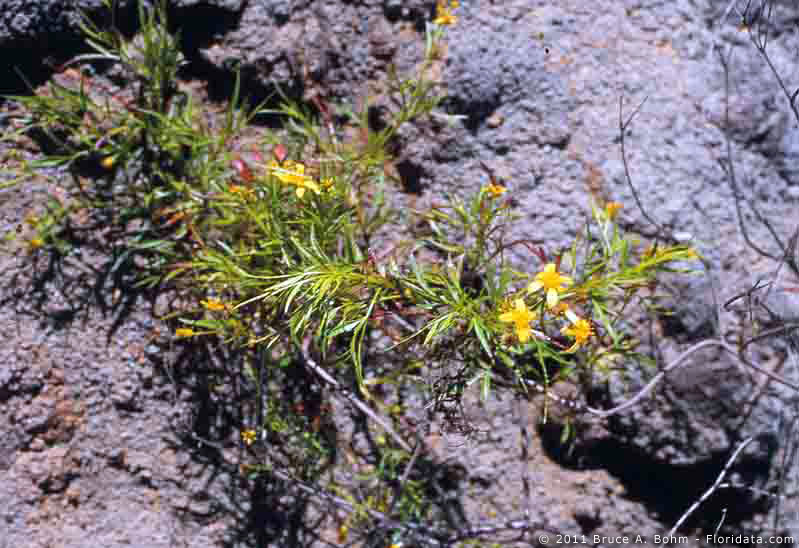
Species of Bidens are widespread on the islands, and with their bright yellow flower displays, easy to find. Examples include Bidens sandwicensis subsp. confusa (image) growing near the edge of the Iliau Loop Trail overlooking Waimea Canyon; and Bidens campylotheca (see image), a rare species known from several islands but here photographed in the Rare Plant Nursery on the Big Island. The next species (image below) is Bidens cosmoides, a species restricted to a few sites on Kaua`i. Owing to the unusual flower head of this species with its strongly exerted stamens, an obvious adaptation for bird pollination, it was placed in its own section of Bidens at one time. Supporting that conclusion was the apparent inability of B. cosmoides to cross with other island Bidens species. This was subsequently shown to be in error when the crosses were redone using fresh pollen; all species of Bidens on the islands are inter-fertile. Hybrids are rarely found in nature, however, since the species occupy specialized niches and normally do not encounter one another in the wild.
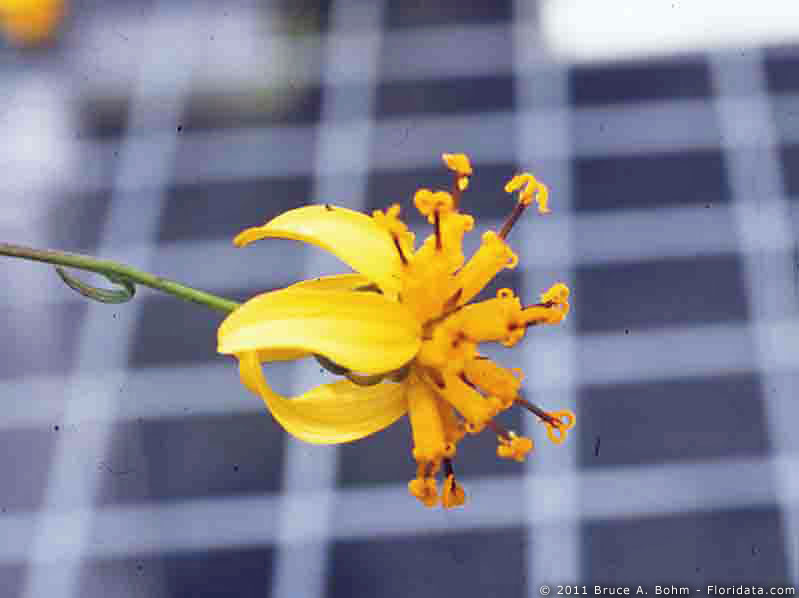
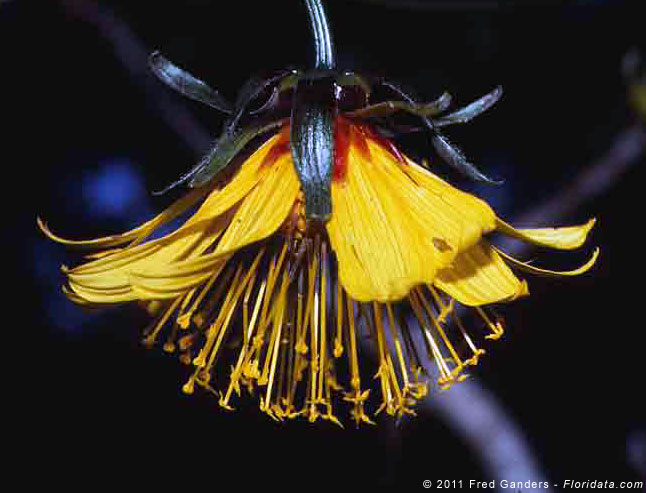
Fred Ganders and Mary Berbee, former colleagues of mine at the University of British Columbia, and their student Mona Pirseyedi (2000), studied the evolutionary relationships of the Hawaiian and other Pacific Island species of Bidens using ITS gene sequence data. Their data clearly showed that the Hawaiian species constitute a single evolutionary unit; that is to say, the island species arose from a single colonization event. There was so little variation in the DNA sequences from the tested species that it was not possible to determine relationships among the island species. A second find was that species from the Marquesas were also very closely related to the Hawaiian species. Again, the specific relationship between Marquesan and Hawaiian species was not determined. The nearest neighbors of Polynesian Bidens, however, were clearly established as Mexican and Caribbean species belonging to section Campylotheca. An interesting outcome of the study involved a recently discovered species of Bidens from Starbucks Island ( 5°37'S, 155°56' W; no association with coffee of the same name), a small speck of land that is part of the Line Islands, which in turn are part of the Republic of Kiribati (formerly the Gilbert Islands). How the Starbucks Island Bidens got to the atoll remains a mystery, but the DNA studies showed that it is not related to the Polynesian species studied by Ganders and his coworkers; rather, it is related to species native to Central and South America in section Greenmanii which requires a second colonization event to have occurred.
In collaboration with Professor Ganders, our lab at UBC investigated pigment variation within and among the species of Hawaiian Bidens. (Ganders et al., 1990). The specific group of pigments examined, the flavonoids, are comparatively easy to study–enabling us to examine large numbers of specimens–and information on these compounds in continental Bidens species was available for comparison. The overall pigment chemistry of the island species agreed well with information available on continental species. However, pigment patterns among species showed no characteristic patterns; that is to say, no species (or subspecies or variety) could be clearly defined on the basis of its pigments. Furthermore, variation within species was extreme, often with individual plants growing adjacent to one another exhibiting totally different arrays of flavonoids. Since leaves and flowers often accumulate different arrays of pigments, comparisons at this level were also done. The results were identical: extreme variation seems to be the rule in this group of plants. Insofar as this was one of the first studies of flavonoid variation done in any native Hawaiian species–particularly with the large number of samples used–we wondered if levels of variation of this sort was a feature of plants long separated from their continental ancestors. This idea was examined further by looking at flavonoid pigment variation in several other endemic species representing different families, or in the case of the Asteraceae, different tribes (the taxonomic unit beneath subspecies). The expanded study of variation involved three species, Wilkesia gymnoxiphium (iliau, Asteraceae) which we met above; Vaccinium reticulatum (`öhelo, Ericaceae), and Metrosideros polymorpha (`öhi`a, Myrtaceae), which will be discussed in below. In each of these cases, flavonoid variation amounted to nothing more than minor fluctuations in concentration of pigments; the patterns were virtually super-imposable within each species. A possible explanation for these results could involve the genetic control system that oversees pigment production (such control systems are known in other plant species). In the case of pigment production in Vaccinium and Metrosideros it is reasonable to suggest that the control system was well established in the ancestors, while in the case of Bidens, something occurred in the process of colonization and/or adaptive radiation that upset the controls. By comparison, pigment patterns in continental Bidens, at least to the extent that they have been studied, appear consistent within species.
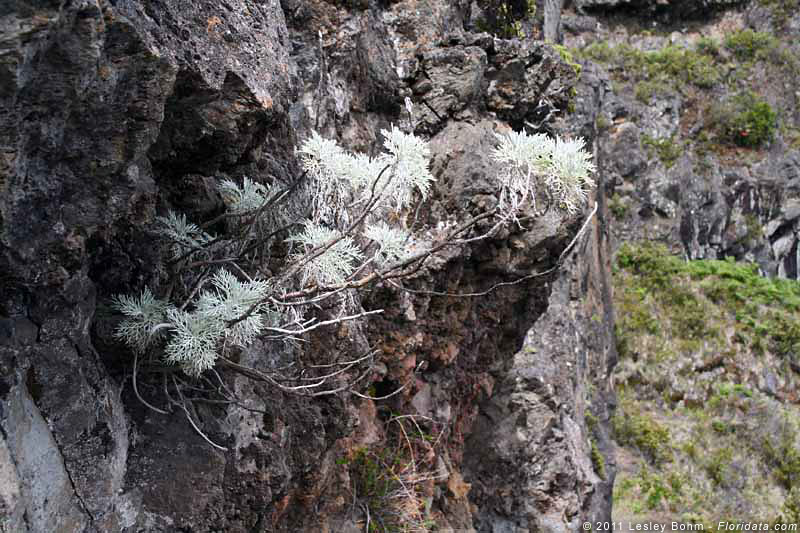
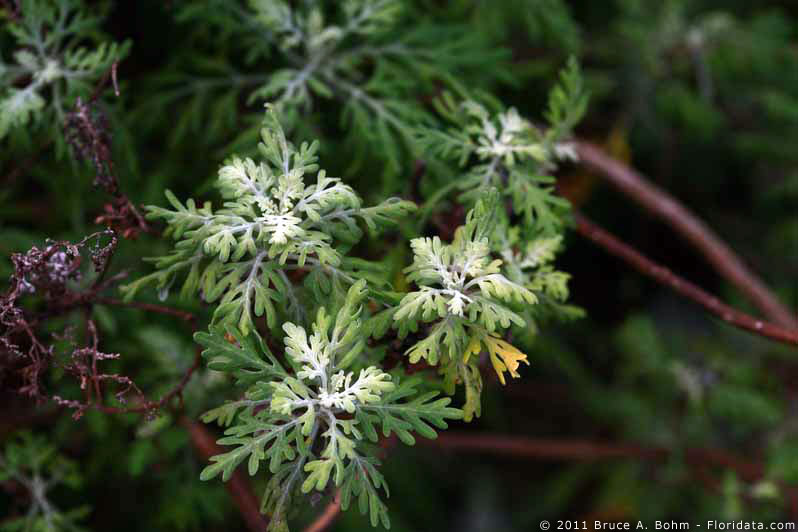
Artemisia, one of the larger genera in the Asteraceae, consists of about 400 species with centers of diversity in China, North America, and Europe; a few species occur in western South America, with a single outlier in South Africa. Mabberley (p. 69) briefly mentions some of the more noteworthy members of the genus, among which are A. absintheum, wormwood, the flavoring agent in absinthe; A. annua, a Chinese species that is the source of effective anti-malarial drugs (e.g. qinghaosu); A. dracunculus, familiarly known as tarragon; A. dracunculoides, Russian tarragon, considered by many as less attractive as a flavoring agent; A. herba-alba, the plant referred to as wormwood in the Bible; A. pontica, Roman wormwood, the flavor component of vermouth; and the North American A. tridentata, the sagebrush of dry western parts of North America.
Four species are known in the Hawaiian flora, the widespread, weedy Eurasian A. vulgaris, the common mugwort; and three species endemic to the islands, A. australis, which occurs on all of the main islands; and the two island endemics A. mauiensis (see image), photographed in Haleakalä, and A. kauaiensis. (see image). The latter species was photographed in the Limahuli Garden. Christopher Hobbs and Bruce Baldwin of the University of California, Berkeley (2008) have reported that the Hawaiian species of Artemisia have an eastern Asian species as their nearest relative. The three island species are very similar and are thought to have been the result of a single colonization event, followed by differentiation on the islands.

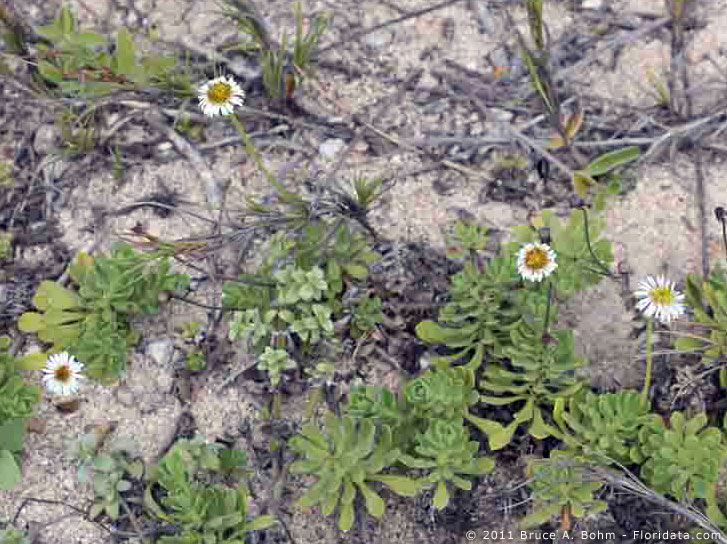
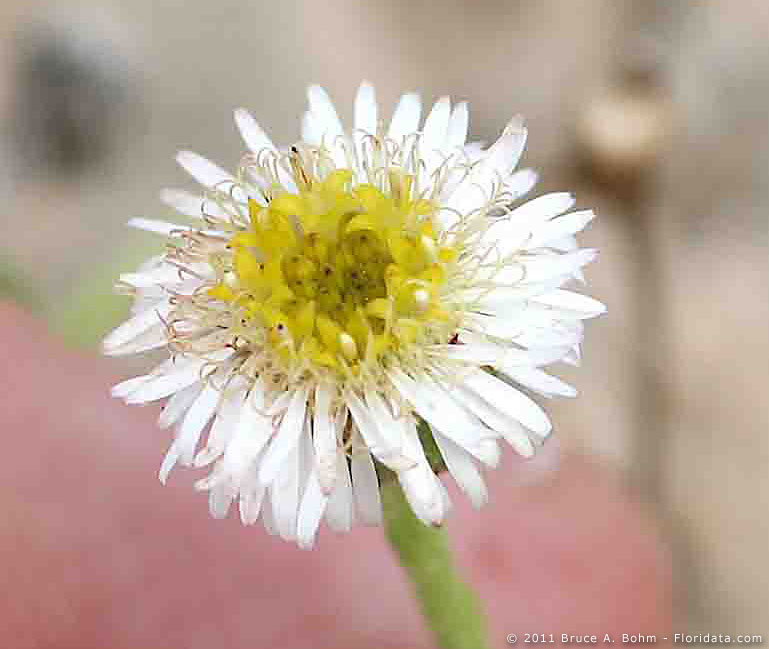
Our next example involves another genus that is not endemic on the islands, but does have several uniquely Hawaiian species. Tetramolopium consists of 38 species, the majority of which are native to New Guinea. One species is known from the Cook Islands in the southern Pacific. Eleven species are–or were–endemic on the Hawaiian Islands. Only a few species of the genus is the islands are at all common; many are marked rare and/or endangered, or simply don't exist anymore. One of the most common species, and one that is comparatively easy to find in nature, is T. humile (see images). This attractive little daisy occurs at medium to high elevation on Haleakalä, and on all of the volcanic mountains on the Big Island. Two subspecies are recognized, subsp. haleakalae, whose name informs us where it occurs, but which is further distinguished from subsp. humile by some leaf and floral display features. One of the more interesting members of the genus is T. rockii (see image) which occurs only in northwestern Moloka`i in the Mo`omomi Dunes area. Two varieties are recognized based on leaf characteristics and habitat: one grows nearer the coast, the other a bit further inland. This species grows on lithified calcareous dunes.
A combination of morphological and molecular supports the view that the Hawaiian species of Tetramolopium are most closely related to, and have been derived from, a progenitor species native to New Guinea (Lowrey et al., 2005). A single colonization event with subsequent diversification gave rise to the present array of Hawaiian species (including the extinct ones). The finding of a new species of Tetramolopium on Mitiaro, one of the Cook Islands, described as T. mitiaroense in the Lowrey et al. paper, could be accounted for by two possible routes: either directly from New Guinea; or from the Hawaiian Islands. Since the Cook Island species is closely related to Hawaiian species, the second route is considered the more likely. A likely means of long distance dispersal from one of the Hawaiian Islands is thought to be the Pacific Golden-Plover (Pluvialis fulca) whose flight path takes it from its breeding grounds in Siberia and Alaska to its winter range as far south as Australia, New Zealand, and the Tuamotu Archipelago in French Polynesia. The Golden-Plover is a regular visitor to the Southern Cook Islands, including Mitiaro.
Owing to the extreme isolation of the Hawaiian islands, it was long thought that they served only as a target–referred to as a sink–for highly random and rare dispersal events. Their isolation prevented them from being seriously considered as a source of propagules. Discovering that the Cook Island Tetramolopium was derived from a Hawaiian progenitor suggests that the source-sink concept does not necessarily hold true. Were this the only example of the Hawaiian Islands acting as a source it might be possible to explain this as a one-off example. As it turns out, however, it is not the only example. Others involve southern Pacific species of Plantago (Plantaginaceae), Melicope (Rutaceae), and Santalum (Santalaceae). Authors of the Melicope study, which we will be meet below, suggest, that members of several Hawaiian genera with closely related species in the southern Pacific may have arisen in this way.
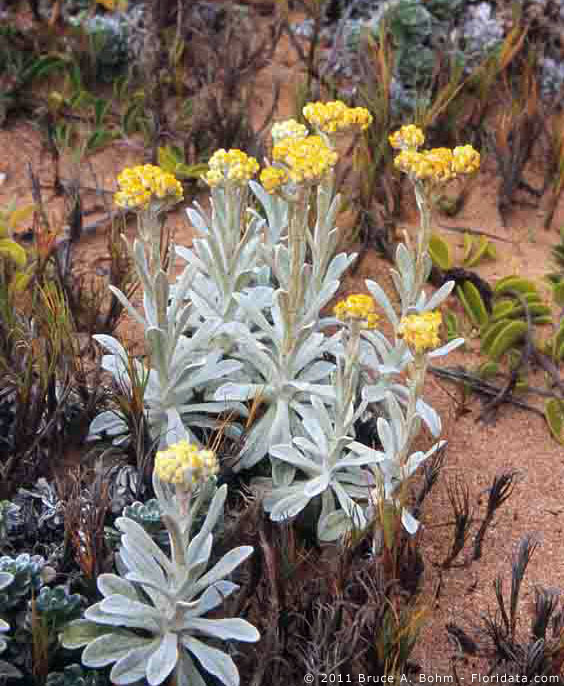
Although the next example is listed in the Manual under the generic name Gnaphalium, commonly known as cudweeds, current authorities prefer the name Pseudognaphalium. Gnaphalium consists of about 38 species according to Mabberley (p. 365), whereas Pseudognaphalium, taken to include Gnaphalium, has about 100. Regardless of which of these names is recognized–we'll stay with the Manual here–there are three species on the Hawaiian Islands, the Australian G. japonicum and the North American G. purpureum, both naturalized, and one endemic, G. sandwicensium. Gnaphalium sandwicensium is highly variable with regard to several leaf features including size, shape, pubescence, and, to some extent, geography. The plant illustrated is G. sandwicensium var. molokaiense (see image). This variety, as is clear from the photograph, is characterized by its dense, white pubescence. It occurs only in coastal habitats on western Moloka`i.
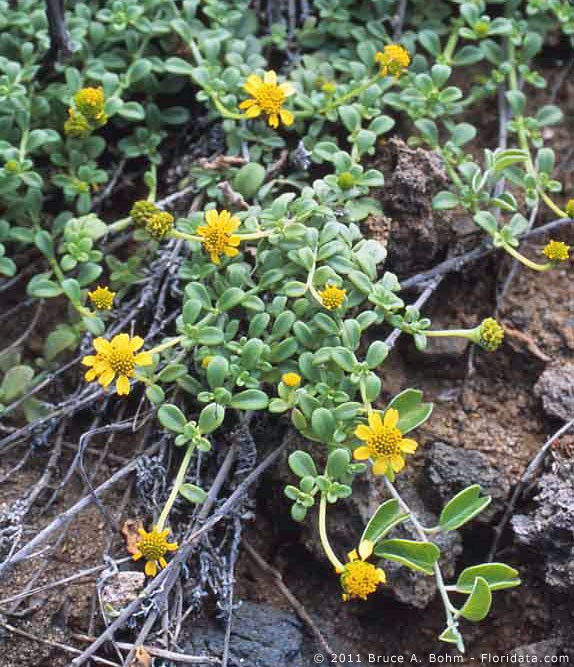
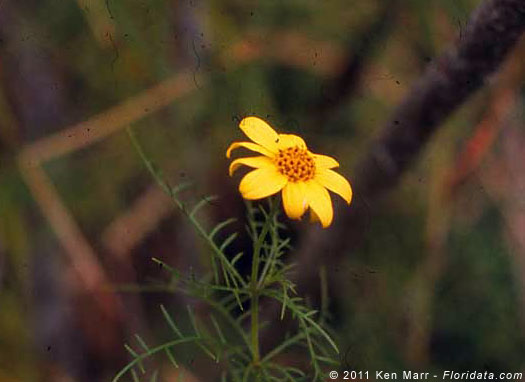
Sharing sea-side habitats on Moloka`i with Gnaphalium, but fairly common on all of the other islands, is Lipochaeta integrifolia (see image). This sprawling herb produces an abundance of attractive flowers. Lipochaeta tenuifolia (see image), is a rare species that occurs in mesic forest in the central Wai`anae Mountains of O`ahu. Its deeply cut leaves are a characteristic feature of this species. According to the Manual, Lipochaeta consists of 20 species, whereas Mabberley (p. 494) says only six. The difference between these two treatments reflects uncertainty of relationships within this and related genera and should not detract in any way from appreciating this attractive species in the field.
There is evidence that Lipochaeta may have originated from a member of the New World tropical genus Wedelia or a Wedelia-like ancestor. One species is known from the Hawaiian Islands, W. trilobata. It is not uncommon to find this species occurring in extensive fields (image). An individual flower is seen in.
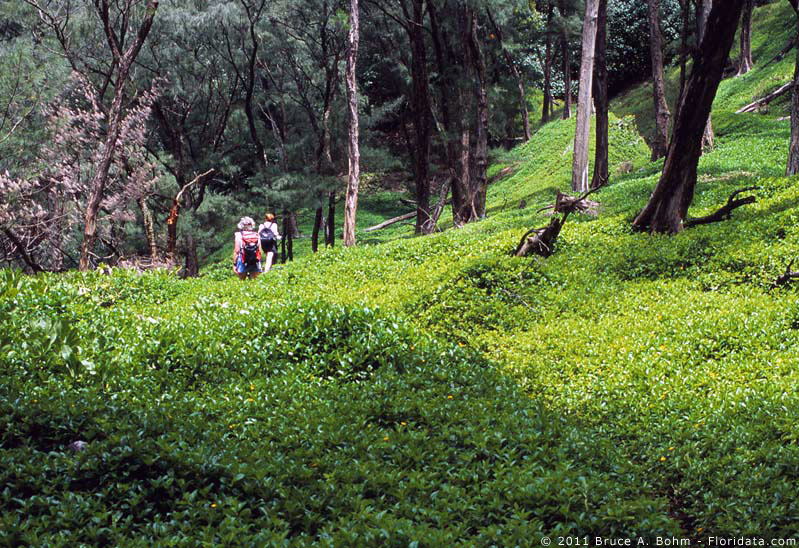

Many members of this family are common weeds in the islands among which are Verbesina encelioides (image), the golden crown-beard. This native of Mexico and southwestern United States is widespread in the islands readily occupying disturbed sites, particularly roadsides and abandoned fields. One of the places in which I found this species was a small fenced pen in which several domestic swine were being kept. The only plants visible in the enclosure were several golden crown-beards (see image). Since everything within sight appears to have been eaten, why were these large plants left standing? I suspect that even pigs find that golden crown-beards bad-tasting. This is likely an example of protection against herbivory based upon the presence of a mixture of low molecular weight organic compounds that the plants accumulate.
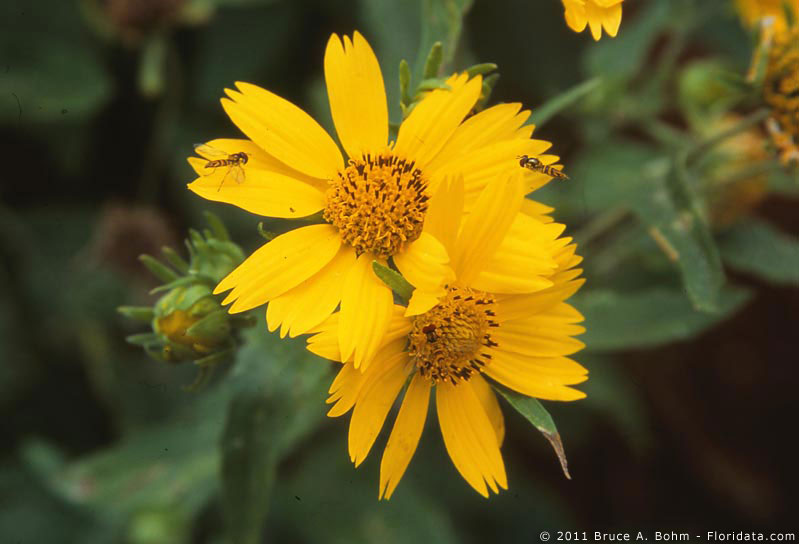
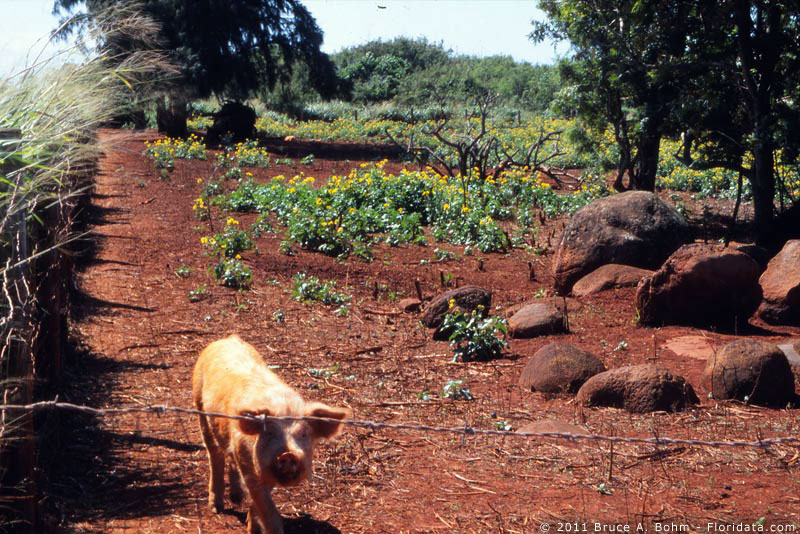
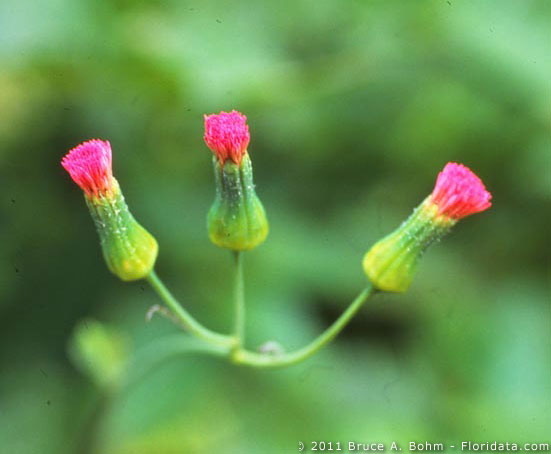
One of my favorite little plants on the islands is the petite, brightly colored Emilia fosbergii (image) known as pualele in Hawaiian. There are three species of Emilia on the islands, pualele being the most common in my experience. It is known from all islands, including Ni`ihau and Kaho`olawe, and from Kure Atoll. To be precise, at least according to the Hawaiian Dictionary (Pukui & Elbert, p. 346), pualele is only used to identify Emilia on Ni`ihau; otherwise pualele is the common name of Sonchus oleraceus, the sow thistle, which is widely distributed on the islands.
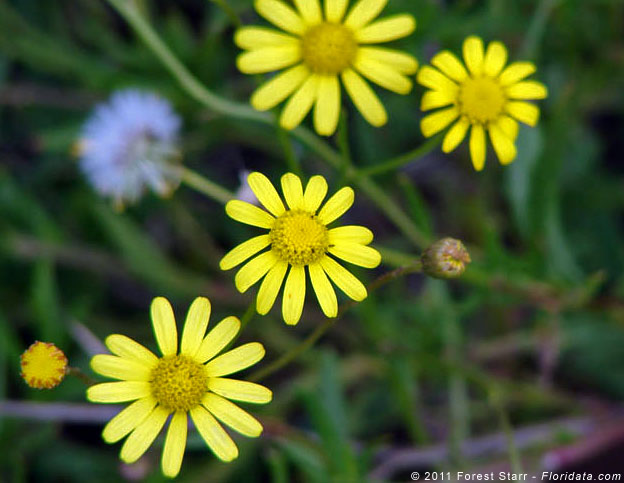
There are many other members of the sunflower family on the Hawaiian Islands, many of which are weedy species, dandelion and cat's ear (Hypochoeris radiata) among others, not surprisingly. One of the weedy species in particular has become a serious pest wherever it gets a foothold. Senecio madagascariensis (see image), locally known as fireweed or Madagascar ragwort, was only recently (1995) described from the islands, although there was a reported sighting some years earlier. This species of the wide ranging genus Senecio is native to southern Africa and Madagascar. The plant is toxic to range cattle owing to the presence of poisonous pyrrolizidine alkaloids in its aerial parts. Control by herbicides is possible but native and desirable species are also susceptible. Biocontrol methods involving insect species are being tested.
Literature cited…
Baldwin, B. G. and M. J. Sanderson. 1998. Age and rate of diversification of the Hawaiian silversword alliance (Compositae). Proceedings of the National Academy of Sciences, U.S.A. 95: 9402-9406.
Baldwin, B. G. and B. L. Wessa. 2000. Origin and relationships of the tarweed-silversword lineage (Compositae–Madiinae). American Journal of Botany 87: 1890-1908.
Carlquist, S. 1959. Studies on Madinae: anatomy, cytology and evolutionary relationships. Aliso 4: 171-236.
Carlquist, S. 1974. Island Biology. Columbia Univ. Press, New York.
Carlquist, S. 1980. Hawaii, a natural history. Pacific Tropical Botanical Garden, Lawa`i, HI.
Carlquist, S., B. G. Baldwin, and G. D. Carr (eds.). 2003. Tarweeds and Silverswords: Evolution of the Madiinae (Asteraceae). Missouri Botanical Garden Press, St. Louis.
Carr, G. D. 1985. Monograph of the Hawaiian Madiinae (Asteraceae): Argyroxiphium, Dubautia, and Wilkesia. Allertonia 4: 1-123.
Carr, G. D. and D. W. Kyhos. 1981. Adaptive radiation in the Hawaiian silversword alliance (Compositae–Madiinae). I. Cytogenetics of spontaneous hybrids. Evolution 35: 543-556.
Carr, G. D. and D. W. Kyhos. 1986. Adaptive radiation in the Hawaiian silversword alliance (Compositae–Madiinae). II. Cytogenetics of artificial and natural hybrids. Evolution 40: 959-976.
Carr, G. D., B. G. Baldwin and D. W. Kyhos. 1996. Cytogenetic implications of artificial hybrids between the Hawaiian silversword alliance and North American tarweeds Asteraceae: Heliantheae–Madiinae). American Journal of Botany 83: 653-660.
Ganders, F. R., M. Berbee, and M. Pirseyedi. 2000. ITS base sequence phylogeny in Bidens (Asteraceae): evidence for continental relatives of Hawaiian and Marquesan Bidens. Systematic Botany 25: 122-133.
F. R. Ganders, B. A. Bohm and S. P. McCormick. 1990. Flavonoid variation in Hawaiian Bidens. Systematic Botany 15: 231-239.
Gray, A. 1852. Account of Argyroxiphium, a remarkable genus of Compositae, belonging to the mountains of the Sandwich Islands. Proceedings of the American Academy of Arts 2: 159-160.
Hobbs, C. and B. G. Baldwin. 2008. Origin of Hawaiian Artemisia (Compositae–Anthemideae). Abstract, Botanical Society of America meeting. Presentation Number: 62016; Abstract ID:891.
Keck, D. D. 1936. The Hawaiian silverswords: systematics, affinities, and phytogeographic problems of the genus Argyroxiphium. Occasional Papers of the Bernice P. Bishop Museum 11: 1-38.
Lowrey, T. K., R. Whitkus and W. R. Sykes. 2005. A new species of Tetramolopium (Asteraceae) from Mitiaro, Cook Islands: biogeography, phylogenetic relationships and dispersal. Systematic Botany 30: 448-455.
November 29, 2011